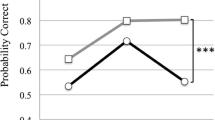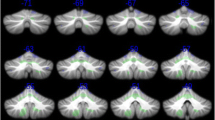Abstract
Although there is increasing evidence that cerebellar loss of grey matter volume (GMV) is associated with affective deficits, this has not been tested for patients suffering from Huntington’s disease (HD), who show a pronounced impairment in the recognition of anger. We assessed GMV in 18 symptomatic HD patients and 18 healthy controls using voxel-based morphometry. The GMV of cerebellar subregions was correlated with participants’ intensity and accuracy ratings for facial expressions of basic emotions from the Karolinska Directed Emotional Faces (Lundqvist et al. 1998). The patients gave lower and less accurate anger ratings for angry faces than controls. This anger recognition deficit was correlated with atrophy of selected hemispheric and vermal regions of the cerebellum. Furthermore, cerebellar volume reductions of the HD patients were associated with longer disease duration and greater functional impairment. The data imply that anger recognition deficits could potentially serve as indicators of disease onset and progression in HD. Furthermore, the patients might profit from specific affect trainings.



Similar content being viewed by others
References
Henley SM, Novak MJ, Frost C, King J, Tabrizi SJ, Warren JD. Emotion recognition in Huntington's disease: a systematic review. Neurosci Biobehav Rev. 2012;361:237–53.
Calder AJ, Keane J, Manes F, Antoun N, Young AW. Impaired recognition and experience of disgust following brain injury. Nat Neurosci. 2000;3:1077–8.
Calder AJ, Keane J, Lawrence AD, Manes F. Impaired recognition of anger following damage to the ventral striatum. Brain. 2004;127:1958–69.
Ille R, Scharmüller W, Enzinger C, Schöggl H, Kapfhammer HP, Schienle A. Emotion recognition and experience in Huntington disease: a voxel-based morphometry study. J Psychiatry Neurosci. 2011;36:383–90.
Kipps CM, Duggins AJ, McCusker EA, Calder AJ. Disgust and happiness recognition correlate with anteroventral insula and amygdala volume respectively in preclinical Huntington's disease. J Cogn Neurosci. 2007;197:1206–17.
Scahill RI, Hobbs NZ, Say MJ, Bechtel N, Henley SM, Hyare H, et al. Clinical impairment in premanifest and early Huntington's disease is associated with regionally specific atrophy. Hum Brain Mapp. 2013;34:519–29.
Fennema-Notestine C, Archibald SL, Jacobson MW, Corey-Bloom J, Paulsen JS, Peavy GM, et al. In vivo evidence of cerebellar atrophy and cerebral white matter loss in Huntington disease. Neurology. 2004;636:989–95.
Rosas HD, Koroshetz WJ, Chen YI, Skeuse C, Vangel M, Cudkowicz ME, et al. Evidence for more widespread cerebral pathology in early HD: an MRI-based morphometric analysis. Neurology. 2003;6010:1615–20.
Schmahmann JD, Caplan D. Cognition, emotion and the cerebellum. Brain. 2006;129:290–2.
Baumann O, Mattingley JB. Functional topography of primary emotion processing in the human cerebellum. Neuroimage. 2012;61:805–11.
Huntington Study Group. Unified Huntington’s Disease Rating Scale: reliability and consistency. Mov Disord. 1996;11:136–42.
Hautzinger M, Bailer M, Worall H, Keller F. Beck-Depressions-Inventar BDI. Bearbeitung der deutschen Ausgabe. Testhandbuch. Bern: Huber; 1994.
Ihl R, Grass-Kapanke B, Lahrem P, Brinkmeyer J, Fischer S, Gaab N. Development and validation of a test for early diagnosis of dementia with differentiation from depression TFDD. Fortschr Neurol Psychiatr. 2000;68:413–22.
Lundqvist D, Flykt A, Öhman A. The Karolinska Directed Emotional Faces-KDEF, CD ROM. Stockholm: Department of Clinical Neuroscience, Psychology Section, Karolinska Institute; 1998. ISBN 91-630-7164-9.
Schmahmann JD, Sherman C. The cerebellar cognitive affective syndrome. Brain. 1998;121:561–79.
Schmahmann JD, Doyon J, Petrides M, Evans AC, Toga AW. MRI atlas of the human cerebellum. San Diego: Academic; 2000.
Tzourio-Mazoyer N, Landeau B, Papathanassiou D, Crivello F, Etard O, Delcroix N, et al. Automated anatomical labeling of activations in SPM using a macroscopic anatomical parcellation of the MNI MRI single-subject brain. Neuroimage. 2002;15:273–89.
Calder AJ, Keane J, Young AW, Lawrence AD, Mason S, Barker RA. The relation between anger and different forms of disgust: implications for emotion recognition impairments in Huntington's disease. Neuropsychologia. 2010;48:2719–29.
Ille R, Holl AK, Kapfhammer HP, Reisinger K, Schäfer A, Schienle A. Emotion recognition and experience in Huntington's disease: is there a differential impairment? Psychiatry Res. 2011;188:377–82.
Paradiso S, Robinson RG, Andreasen NC, Downhill JE, Davidson RJ, Kirchner PT, et al. Emotional activation of limbic circuitry in elderly normal subjects in a PET study. Am J Psychiatry. 1997;1543:384–9.
Schmahmann JD. An emerging concept. The cerebellar contribution to higher function. Arch Neurol. 1991;4811:1178–87.
Ruocco HH, Lopes-Cendes I, Li LM, Santos-Silva M, Cendes F. Striatal and extrastriatal atrophy in Huntington's disease and its relationship with length of the CAG repeat. Braz J Med Biol Res. 2006;398:1129–36.
Acknowledgments
This study was supported by the Austrian Science Fund (FWF), project number P20779-B02.
Conflict of Interest Statement
The authors declare that there are no financial and personal relationships that biased their work (e.g., consultancies, stock ownership, equity interests, and patent licensing arrangements).
Author information
Authors and Affiliations
Corresponding author
Rights and permissions
About this article
Cite this article
Scharmüller, W., Ille, R. & Schienle, A. Cerebellar Contribution to Anger Recognition Deficits in Huntington’s Disease. Cerebellum 12, 819–825 (2013). https://doi.org/10.1007/s12311-013-0492-9
Published:
Issue Date:
DOI: https://doi.org/10.1007/s12311-013-0492-9




